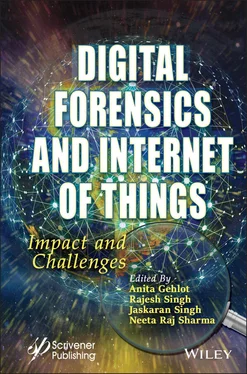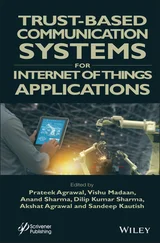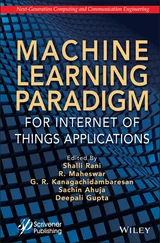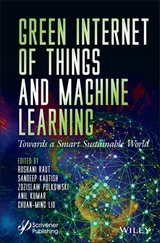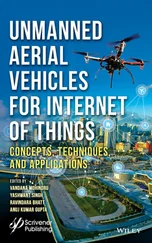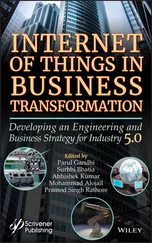Digital Forensics and Internet of Things
Здесь есть возможность читать онлайн «Digital Forensics and Internet of Things» — ознакомительный отрывок электронной книги совершенно бесплатно, а после прочтения отрывка купить полную версию. В некоторых случаях можно слушать аудио, скачать через торрент в формате fb2 и присутствует краткое содержание. Жанр: unrecognised, на английском языке. Описание произведения, (предисловие) а так же отзывы посетителей доступны на портале библиотеки ЛибКат.
- Название:Digital Forensics and Internet of Things
- Автор:
- Жанр:
- Год:неизвестен
- ISBN:нет данных
- Рейтинг книги:3 / 5. Голосов: 1
-
Избранное:Добавить в избранное
- Отзывы:
-
Ваша оценка:
- 60
- 1
- 2
- 3
- 4
- 5
Digital Forensics and Internet of Things: краткое содержание, описание и аннотация
Предлагаем к чтению аннотацию, описание, краткое содержание или предисловие (зависит от того, что написал сам автор книги «Digital Forensics and Internet of Things»). Если вы не нашли необходимую информацию о книге — напишите в комментариях, мы постараемся отыскать её.
It pays to be ahead of the criminal, and this book helps organizations and people to create a path to achieve this goal.
Digital Forensics and Internet of Things Audience
Digital Forensics and Internet of Things — читать онлайн ознакомительный отрывок
Ниже представлен текст книги, разбитый по страницам. Система сохранения места последней прочитанной страницы, позволяет с удобством читать онлайн бесплатно книгу «Digital Forensics and Internet of Things», без необходимости каждый раз заново искать на чём Вы остановились. Поставьте закладку, и сможете в любой момент перейти на страницу, на которой закончили чтение.
Интервал:
Закладка:
Jaskaran Singh
Forensic Sciences, Sharda University, India and
Neeta Raj Sharma
Biotechnology & BioSciences, Lovely Professional University, India

This edition first published 2022 by John Wiley & Sons, Inc., Ill River Street, Hoboken, NJ 07030, USA and Scrivener Publishing LLC, 100 Cummings Center, Suite 541J, Beverly, MA 01915, USA © 2022 Scrivener Publishing LLC
For more information about Scrivener publications please visit www.scrivenerpublishing.com.
All rights reserved. No part of this publication may be reproduced, stored in a retrieval system, or transmitted, in any form or by any means, electronic, mechanical, photocopying, recording, or otherwise, except as permitted by law. Advice on how to obtain permission to reuse material from this title is available at http://www.wiley.com/go/permissions.
Wiley Global Headquarters
111 River Street, Hoboken, NJ 07030, USA
For details of our global editorial offices, customer services, and more information about Wiley products visit us at www.wiley.com.
Limit of Liability/Disclaimer of Warranty
While the publisher and authors have used their best efforts in preparing this work, they make no representations or warranties with respect to the accuracy or completeness of the contents of this work and speciically disclaim all warranties, including without limitation any implied warranties of merchantability or fitness for a particular purpose. No warranty may be created or extended by sales representatives, written sales materials, or promotional statements for this work. The fact that an organization, website, or product is referred to in this work as a citation and/or potential source of further information does not mean that the publisher and authors endorse the information or services the organization, website, or product may provide or recommendations it may make. This work is sold with the understanding that the publisher is not engaged in rendering professional services. Te advice and strategies contained herein may not be suitable for your situation. You should consult with a specialist where appropriate. Neither the publisher nor authors shall be liable for any loss of proit or any other commercial damages, including but not limited to special, incidental, consequential, or other damages. Further, readers should be aware that websites listed in this work may have changed or disappeared between when this work was written and when it is read.
Library of Congress Cataloging-in-Publication Data
ISBN 978-1-119-76878-4
Cover image: Pixabay.Com
Cover design by Russell Richardson
Set in size of 11pt and Minion Pro by Manila Typesetting Company, Makati, Philippines Printed in the USA
10 9 8 7 6 5 4 3 2 1
Preface
This book provides an opportunity to readers in the era of digitalization of forensic science and application of Internet of Things for the provision of technical benefits to the stakeholders. IoT forensics attempts to align its workflow to that of any forensics practice—investigators identify, interpret, preserve, analyse and present any relevant data. Like any investigation, a timeline is constructed, and, with the aid of smart devices providing data, investigators might be able to capture much more specific data points than in a traditional crime.
Currently, there exists no defined and accepted standard for IoT forensic investigations. This can be attributed in part to the heterogeneous nature of IoT.
Chapters 1- 8culminates in the amalgamation of Xilix FPGA and Xilix IP cores, VANET and IOT. The application of such tools in the forensic sciences is the gist of the book. However, Chapters 9- 15discuss the core aspects of machine learning in the areas of healthcare, criminal profiling and digital cyber investigation.
Cyber and digital frauds are the hallmark of today’s era. There is an urgent need to produce knowledgeable resources for curbing such crimes; thus, this book will serve as a perfect instance for getting the best source of expertise. Additionally, it serves as a revolutionary merit for identification and apprehension of criminals in a smarter way.
Case studies related to digital and cyber forensics is a key feature of the book. The content of chapters serves as a jewel in the crown for law enforcement agencies, advocates, forensic experts and students. Hence, we hope the book is an asset for readers and users as they become aware of the ubiquitous societal issues of digital and cybercrimes. Finally, we owe a large debt of gratitude to Scrivener Publishing and Wiley and all authors of the book in particular, for their continued support and patience.
Prof. (Dr.) Anita Gehlot
Uttaranchal University, India
Prof. (Dr.) Rajesh Singh
Uttaranchal University, India
Dr. Jaskaran Singh
Sharda University, India
Dr. Neeta Raj Sharma
Lovely Professional University, India
The Editors
February 2022
1
Face Recognition–Based Surveillance System: A New Paradigm for Criminal Profiling
Payal Singh, Sneha Gupta, Vipul Gupta, Piyush Kuchhal and Arpit Jain*
Electrical and Electronics Engineering Department, UPES, Dehradun, India
Abstract
Security is the most important aspect in any spheres. We have to ensure these technologies evolve along with the advancement of various technology in the field of machine vision and artificial intelligence. The system of facial detection has become a topic of interest. It is widely used for human identification due to its capabilities that give accurate results. It is majorly used for security purposes. This manuscript provides method of face detection and its applications. Using this method, locking system will be designed to ensure safety and security in all types of places. Surveillance systems help in close observation and looking for improper behavior. Then, it performs actions on the data that has been provides to it.
Keywords:Face recognition, python, Raspberry Pi, deep learning, locking system, image processing, eigen faces, fisher faces
1.1 Introduction
Face detection is the method which is pre-owned to identify or verify an individual’s identity using their face. There can also be image, video, audio, or audio-visual element given to the system. Generally, the data is used to access a system or service. This can be performed in two variations depending on its application. First is when the facial recognition system is taking the input (face) for the first time and registering it for analysis. Second is when the user is authenticated prior to being registered. In this, the incoming data is checked from the existing data in the database, and then, access or permission is granted.
The most important aspect of any security system is to properly identify individuals entering or taking an exit through the entrance. There are several systems that use passwords or pins for identification purposes. But these types of systems are not very effective as these pins and passwords can be stolen or copied easily. The best solution to this is using one’s bio-metric trait. These are highly effective and useful. This system is designed for prevention of security threats in exceptionally secure regions with lesser power utilization and more dependable independent security gadget.
In this paper [1], the researcher has explained about the ongoing development in subject of facial acknowledgment, and executing features check along with acknowledgment proficiently at extent shows genuine difficulties at present methodologies. Here, we introduce a framework, called FaceNet, which straightforwardly takes in planning from facial pictures till the minimal Euclidean space which removes straightforwardly relate to the proportion of features likeness. When its area has been created, undertakings, like check with bunching, can handily executed apply quality strategies followed by FaceNet embeddings as peak vectors. In [2], the creators have expressed their technique using a significant convolutional network ready to directly smooth out the genuine introducing, rather than a moderate bottleneck layer as in past significant learning moves close. To get ready, we use triplets of by and large changed organizing/non-planning with face patches made using an original online threesome mining strategy. The benefit of our strategy is much more conspicuous real capability: We achieve top tier face affirmation execution using only 128-bytes per face. On the extensively used Named Countenances in the Wild (LFW) dataset, our structure achieves another record exactness of 99.63%. Our structure cuts the misstep rate conversely with the best dispersed result by 30% on both datasets. We likewise present the idea of consonant embedding, which portray various variants of face embedding (delivered by various organizations) that are viable to one another and consider direct correlation between one another. This paper [3] presents colossal extension face dataset named VGGFace2. The dataset contains 3.31 million pictures of 9,131 subjects, with a typical of 362.6 pictures for each subject. Pictures are downloaded from Google Picture Look and have colossal assortments in present, age, edification, identity, and calling (for instance, performers, contenders, and government authorities). The dataset was accumulated considering three goals: to have both incalculable characters and besides a gigantic number of pictures for each character; to cover a tremendous extent of stance, age, and personality; and to restrict the imprint upheaval. We depict how the dataset was assembled, explicitly the robotized and manual isolating stages to ensure a high accuracy for the photos of each character. To assess face affirmation execution using the new dataset, we train ResNet-50 (with and without Crush and-Excitation blocks) Convolutional Neural Organizations on VGGFace2, on MS-Celeb-1M, and on their affiliation and show that readiness on VGGFace2 prompts further developed affirmation execution over stance and age. Finally, using the models ready on these datasets, we display state of the art execution on all the IARPA Janus face affirmation benchmarks, for instance, IJB-A, IJB-B, and IJB-C, outperforming the previous top tier by an enormous edge. Datasets and models are straightforwardly open [4, 5] Late profound learning-based face detection strategies have accomplished extraordinary execution, yet it actually stays testing to perceive exceptionally low-goal question face like 28 × 28 pixels when CCTV camera is far from the gotten subject. Such face with especially low objective is completely out of detail information of the face character diverged from normal objective in a presentation and subtle relating faces in that. To this end, we propose a Goal Invariant Model (Edge) for having a tendency to such cross-objective face affirmation issues, with three indisputable interests.
Читать дальшеИнтервал:
Закладка:
Похожие книги на «Digital Forensics and Internet of Things»
Представляем Вашему вниманию похожие книги на «Digital Forensics and Internet of Things» списком для выбора. Мы отобрали схожую по названию и смыслу литературу в надежде предоставить читателям больше вариантов отыскать новые, интересные, ещё непрочитанные произведения.
Обсуждение, отзывы о книге «Digital Forensics and Internet of Things» и просто собственные мнения читателей. Оставьте ваши комментарии, напишите, что Вы думаете о произведении, его смысле или главных героях. Укажите что конкретно понравилось, а что нет, и почему Вы так считаете.
